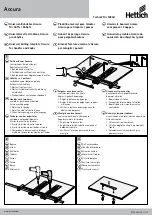
English
10
To Make a Cut
WARNING:
ALWAYS use safety glasses. Everyday
eyeglasses are NOT safety glasses. Also use face or
dust mask if cutting operation is dusty. ALWAYS WEAR
CERTIFIED SAFETY EQUIPMENT.
WARNING:
CUT HAZARD. Before cutting any type of
material, be sure it is firmly anchored or clamped to
prevent slipping.
WARNING:
CUT HAZARD. Let the tool work at its own
pace. Do not overload, blade breakage may occur.
1. Clearly mark the desired cutting area.
2. Switch the tool on before applying pressure and
slowly feed the blade into the workpiece at the
marked location.
WARNING:
CUT HAZARD. Ensure the blade is not in
contact with cutting surface before starting saw.
3. Advance the blade along the cutting line until cut is
completed. Don’t force the tool; let the blade cut at its
own speed.
4. Switch the tool off.
nOTE:
Always use the appropriate type of saw blade for
the workpiece material and type of cut. Cut only with sharp
blades; they cut cleaner, faster and put less strain on the motor
while cutting.
Lock On and Lock Off Button (Fig. A)
Locking the Tool Off
1. Press the lock on/off button
2
all the way to the right
or all the way to the left to lock‑off the variable speed
switch
1
.
Locking the Tool On
1. Push the variable speed switch
1
to turn the unit on.
2. Push the lock on/off button
2
to the right or to the left.
3. While the lock on/off button is pushed to the right or left,
release the variable speed switch to lock the unit on.
4. Push the variable speed switch to release the
lock‑on function.
5. Release the variable speed switch to turn the tool off.
Variable Speed Switch (Fig. A)
Be sure switch is fully OFF before installing the battery.
• Install the battery.
• To turn the tool ON, press the variable speed switch
1
.
• To turn the tool OFF, release the variable speed switch
1
.
Proper Hand Position (Fig. G)
WARNING:
To reduce the risk of serious personal injury,
ALWAYS
use proper hand position as shown.
WARNING:
To reduce the risk of serious personal
injury,
ALWAYS
hold securely in anticipation of a
sudden reaction.
Proper hand position requires one hand on the main
handle
3
.
Installing and Removing the Battery Pack
(Fig. F)
nOTE:
For best results, make sure your battery pack is
fully charged.
To install the battery pack
5
into the tool handle, align the
battery pack with the rails inside the tool’s handle and slide
it into the handle until the battery pack is firmly seated in the
tool and ensure that it does not disengage.
To remove the battery pack from the tool, press the release
button
6
and firmly pull the battery pack out of the tool
handle. Insert it into the charger as described in the charger
section of this manual.
OPERATION
WARNING: To reduce the risk of serious personal
injury, turn unit off and remove the battery pack
before making any adjustments or removing/
installing attachments or accessories.
An
accidental start‑up can cause injury.
Installing/Removing Sanding Sheets
(Fig. E)
Optional Accessory
A diamond shaped platen uses a hook and loop adhesion
system to attach the sanding sheets. The platen allows you
to use it on large flat surfaces and tight spots or corners.
1. Attach the sanding platen accesory as described under
Installing/Removing Accessories
.
2. Align the edges on the sanding sheet with the edge
of the sanding platen and press the sanding sheet
onto the platen.
3. Firmly press the base with the sanding sheet
attached against a flat surface and briefly switch the
tool on. This provides for good adhesion between
the platen and the sanding sheet and also helps to
prevent premature wear.
nOTE:
When the tip of the sanding sheet becomes
worn, detach the sheet from the platen, rotate
and reapply.
Installing/Removing Accessories (Fig. D)
The tool features an exclusive Tool‑Free System for faster
accessory changes and adjustments without the need for
wrenches or hex keys like other oscillating tool systems.
1. Grasp the tool and squeeze the
Tool‑Free accessory
clamp's
4
lever.
2. Clean any residual debris from the tool shaft
9
and
the
Tool‑Free accessory clamp
holder.
3. Slide the accessory between the shaft and the
accessory holder making sure the accessory
engages all of the pins
10
on the holder and is flush
with the shaft.
4. Release the
Tool‑Free accessory
clamp lever.
5. Some accessories, such as scrapers and blades can
be mounted at an angle if required.
Always allow accessories and work piece to cool
before handling.
Summary of Contents for CMCE565
Page 5: ...English 3 11 12 Fig H ...
Page 39: ...Español 37 ...













































